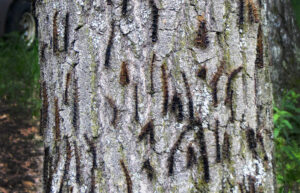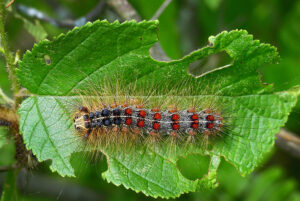By Bill McNee, DNR Forest Health Specialist, Oshkosh
Bill.McNee@wisconsin.gov or 920-360-0942
With this spring’s weather bringing above-average rainfall across most of Wisconsin, we will likely see moderate to heavy mortality of spongy moth caterpillars at many locations this summer.
Last year, the statewide May-June period was the third-driest since recordkeeping began in the late 1800s, according to the NOAA National Centers for Environmental Information. As a result, the effectiveness of the caterpillar-killing fungus, Entomophaga maimaiga, was limited. Spring 2024 is noticeably wetter, and thus, increased effectiveness of E. maimaiga is likely.

Caterpillars killed by nucleopolyhedrosis virus (NPV) hang in an inverted “V” orientation; caterpillars killed by the fungus Entomophaga maimaiga hang vertically.
Reports from early June have shown mortality due to disease has already begun taking place in some areas of the state, according to Wisconsin Department of Natural Resources observers.
When spongy moth populations are high, we often see heavy mortality of the larger caterpillars due to two pathogens. Heavy caterpillar mortality will reduce the severity of the following year’s outbreak and often causes a population crash during the current year. If you observe a heavy die-off of caterpillars, please let your local DNR forest health specialist know about it.
The two pathogens to watch for are:
- Nucleopolyhedrosis virus (NPV): This causes dead caterpillars to hang in an inverted “V” orientation that is sometimes referred to as “wilt disease.” It’s a naturally occurring virus present in the insect’s population. A high proportion of larvae can become infected when caterpillars are abundant because there are many opportunities to transmit the virus to other caterpillars.
- Entomophaga maimaiga: This introduced fungus can quickly infect and kill spongy moth caterpillars. Caterpillars that die from this fungus hang vertically, head down. This fungus is most effective at reducing caterpillar populations when spring weather is wet.
Mortality should be most noticeable between mid-June and mid-July, depending on location, and can appear quickly. The two differing types of dead caterpillars are commonly seen on the same tree, and both are often filled with a brown, foul-smelling liquid. The next heavy rainfall usually washes the cadavers to the ground. In some years, the diseases cause heavy caterpillar mortality before heavy defoliation occurs, and in some years, the heavy tree defoliation occurs prior to a die-off of the caterpillars.
Caterpillars killed by nucleopolyhedrosis virus hang in an inverted “V” orientation; caterpillars killed by the fungus Entomophaga maimaiga hang vertically.
Later this year, be on the lookout for newly produced egg masses that are smaller than normal and about the size of a dime. These are often produced by a female moth carrying a sub-lethal dose of the NPV virus. A noticeable proportion of small egg masses is usually a sign that the spongy moth outbreak is trending downward and is past its peak intensity.

A mature spongy moth larva on a leaf. / Photo Credit: Bill McNee, Wisconsin DNR
To predict the severity of an outbreak in 2025, conduct egg mass surveys this fall when all eggs have been produced. This information will help landowners determine the need for insecticide treatments or other active management in 2025.
A mature spongy moth larva on a leaf.
Property owners are encouraged to examine their trees and take action this spring and summer. Specifically:
- Visit wi.gov for information about managing spongy moth. Management options include burlap collection bands, physically destroying caterpillars and applying insecticide to protect trees.
- Watch this video showing how to use a burlap collection band to catch and kill spongy moth caterpillars.
- Insecticide treatments can be a suitable option for high-value host trees but are not practical for woodlots.
- Water yard trees weekly during dry periods to help reduce tree stress and aid a tree’s recovery from heavy defoliation.
- Avoid touching the hairy caterpillars, as well as the moths and egg masses that will appear later in the summer. The hairs often cause a skin rash, welt or other irritation. Rubbing alcohol can help to remove the hairs and chemical irritants from skin that has been exposed to the hairs.
- Wait to cut down any trees that are defoliated. Healthy hardwood trees usually produce a new set of leaves a few weeks after defoliation.
- Forest management may need to be postponed in areas that are defoliated. Trees will be stressed from heavy defoliation and will often be unable to handle the additional stress from forest thinning.
- Monitor for crown dieback and twolined chestnut borer infestation in trees that were stressed by drought and defoliation over the past few years.
- Consult an arborist or forester for additional management recommendations. When seeking an arborist, check both of these directories: Wisconsin Arborist Association and International Society of Arboriculture.
